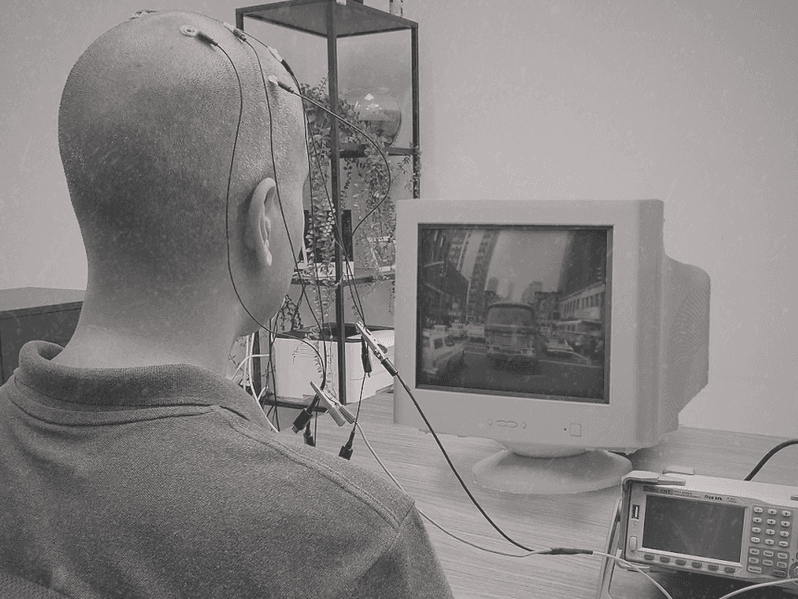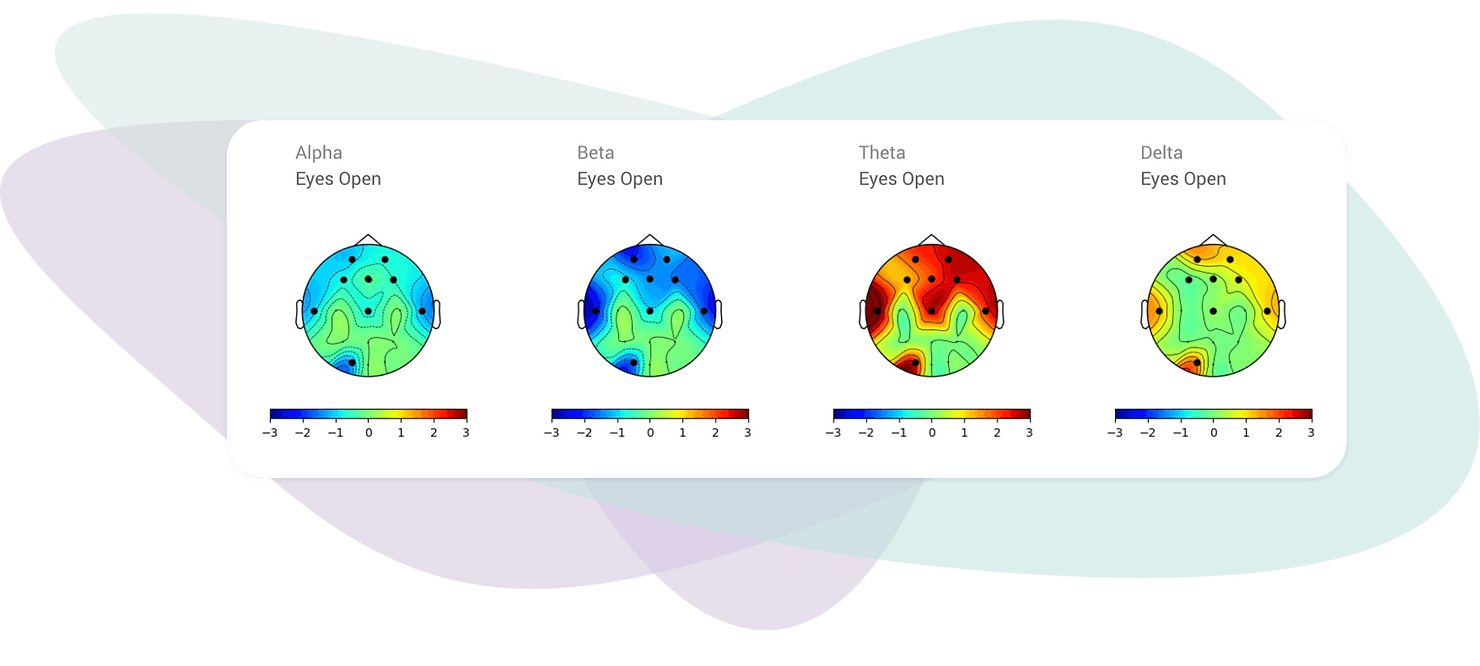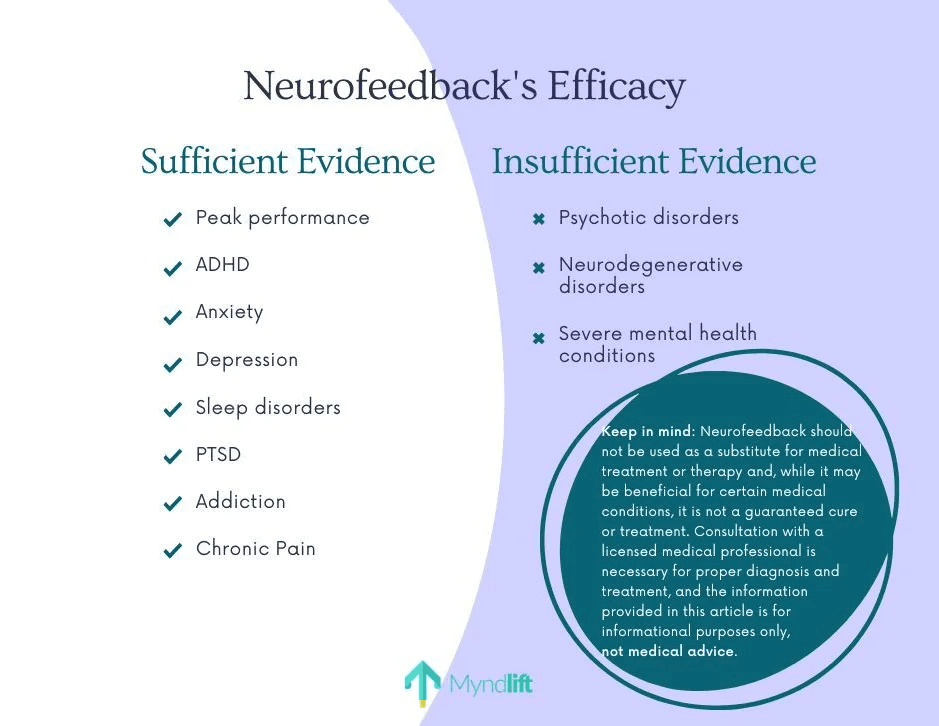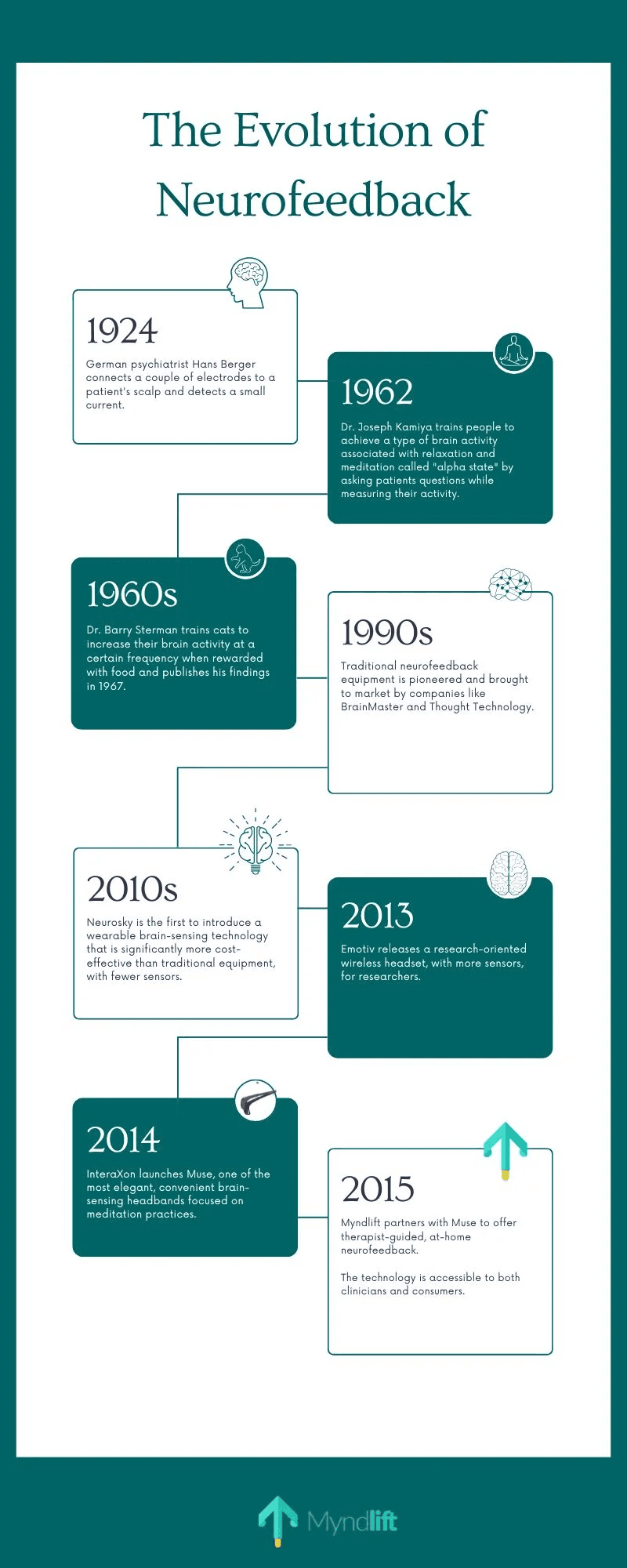In the 1960s, two pioneering scientists, Dr. Joseph Kamiya, and Dr. Barry Sterman, both had the same revolutionary idea: To use a reward system to control brain activity.
Dr. Kamiya trained people to achieve a type of brain activity called "alpha state", which is associated with relaxation and meditation, and Dr. Sterman trained cats to increase their brain activity at a certain frequency when rewarded with food. These discoveries marked the first instances of brain training called neurofeedback and the start of a new era in neuroscience.
Since then, neurofeedback has been the subject of rigorous scientific research. Hundreds of studies have been published in the scientific literature showing that by teaching the brain to self-regulate, this type of training can be a helpful tool for improving mental health.
However, here we are, 60 years after neurofeedback was first developed, and it still feels like mental health's best-kept secret. What is it, and how can it be used?
In this guide, we'll explore the fundamentals of brain training with neurofeedback and answer the many questions you might have about it, such as:
What is neurofeedback?
What's brain mapping?
What can neurofeedback help with?
Where does neurofeedback still need to be proved effective?
What are neurofeedback’s limitations, and how much does it cost?
Where to get neurofeedback?
What is neurofeedback?
To put it simply, neurofeedback is a highly personalized way to train the brain and improve performance.
Unlike regular brain training apps or games you might be familiar with, such as memory tests or puzzles, neurofeedback is a two-way street: It uses sensors to receive input from your brain and modifies the output of the games accordingly. Put simply, it intercepts and offers you direct feedback on your brain activity.
For example, imagine playing a video game while your brain activity is being measured. In this game, you drive a car and must maintain your focus and concentration in order to remain on track.
As you focus and concentrate, sensors measure your brain activity and the game reflects the activity by responding in real time. The better you concentrate, the faster the car goes.
Conversely, if your concentration or focus starts to slip, the car will slow down. In this way, the game rewards focus and concentration, helping to train the brain to stay alert and attentive.
This bidirectional approach means that neurofeedback can teach you to better regulate your brain function and hopefully improve performance in different areas as a result.
What does a neurofeedback session look like?
In old sci-fi movies, neurofeedback was often depicted as a mysterious futuristic technology. The characters would be strapped into a chair and enter a trance-like state while their brains would be hooked up to machines with blinking lights and wires. And that depiction hasn’t improved much with time. Even present-day shows don't get it right when it comes to showing how exactly neurofeedback technology works.
In reality, a neurofeedback session is a much simpler and more comfortable experience. Even back in the day, when neurofeedback required heavy equipment and visits to the clinic, you would simply sit on a chair and gaze at the computer screen while your brain activity was being measured.

Nowadays, you can do neurofeedback while cozying up on your couch with a minimalistic and comfortable head device and “playing” a game on your phone or tablet.
Or even in your car, just like Kirk Cousins, the starting quarterback for the Minnesota Vikings. In the fourth episode of the Netflix series Quarterback, you can see Kirk Cousins in his car streaming a show on his phone while the video reacts solely based on the activity coming from his brain.
But what’s being measured?
The sensors that measure your brain activity are used in a method called EEG (electroencephalography). EEG was developed back in 1924 when the German psychiatrist Hans Berger connected electrodes to a patient's scalp and used a galvanometer to detect a small current.
Since then, we've been recording the rhythmic patterns of electrical signals that are emitted when neurons are firing in our brains.
These patterns of electrical activity occurring in the brain are called brainwaves and are the basis for EEG neurofeedback training. There are five of them (delta, theta, alpha, beta, and gamma), they are associated with different states of consciousness, including alertness, relaxation, as well as sleep, and they can provide insights about your current mental state.
For example, they can indicate when you feel tired, focused, or relaxed. So, for instance, when you're calm, your brain activity measurements will likely show increased alpha brainwave activity. On the other hand, if you're tired and drifting off to sleep, it's more likely that theta will be your dominant brainwave frequency.

How do brainwaves impact training?
During a neurofeedback session, your brain activity is recorded and feedback is provided in real-time, as fast as 4-6 times a second. So, let’s say you’re using neurofeedback to improve your attention.
In this case, your goal is to enhance alpha brainwaves. You place the brain-sensing sensors on your head and look at the screen with a video game, as presented in the image above.
The video game shows you a race between two cars. Once your alpha brainwave activity is enhanced, one of the cars moves faster, which is interpreted by your brain as a reward, especially if the video game shows you’ve received points for moving more quickly.
What’s happening behind the scenes is the following:
The sensors measure your brain signals in real time
The software behind the videogame receives the signals
The software swiftly interprets if your brainwaves are within the target range
If your brain activity is within the right range, your car in the game moves faster. Otherwise, it moves slower.
Over time, with practice and consistency, you will learn to associate the target brain activity with the reward and eventually improve your ability to focus – otherwise known as operant conditioning.
Furthermore, neurofeedback training can be complemented with brain mapping. This allows you to see which specific areas of the brain may benefit from training and to track progress over time.
Visual Guide to Brainwaves: What we've learned about the brain from 1M neurotherapy sessions →
What’s brain mapping?
Some neurofeedback providers use what is called a brain map to provide information about the electrical activity in different regions of the brain. This information can be used to understand the strengths of your brain and where's room for improvement, as well as to personalize the training and monitor your progress.
Furthermore, when used along with the symptom questionnaires, a brain map can provide a more comprehensive assessment of your symptoms. For example, while symptom questionnaires provide insight into your self-reported experiences, a brain map provides objective data about your neurological functioning. Together, these two tools can provide a holistic view of your mental health, which helps your provider develop a comprehensive training plan.
Brain mapping refers to the process of creating a visual representation of the brain's structure and/or function. This can be done using a variety of techniques, including magnetic resonance imaging (MRI), positron emission tomography (PET), electroencephalography (EEG), and magnetoencephalography (MEG).
These maps can help researchers and clinicians understand how different areas of the brain are connected and how they work together to control various functions, such as movement, sensation, language, and emotion. By creating detailed maps of the brain, researchers can also gain insight into neurological disorders and how they can be treated.

Here’s how brain mapping works:
The brainwaves are measured from multiple brain regions and, for each region, they are compared to measurements from other individuals within the same age range and of the same sex.
Each comparison generates a color indicating how far the measurement is from the norm. Red means way above, green means right within the norm, and blue means way below.
It's important to remember that different colors do not necessarily equate to "good" or "bad" results. The interpretation of colors such as red or blue in a brain map can vary depending on many things such as the brainwave and region being analyzed. Therefore, it is best to consult with a trained professional in order to get the most accurate results and understand what the different colors and ranges signify.
Types of brain maps:
There are two main types of brain mapping: structural mapping and functional mapping.
Structural mapping involves creating detailed images of the brain's structure, including its gray matter (cell bodies of neurons) and white matter (the nerve fibers (axons) of neurons, which connect different regions of the brain and enable brain function), or neural pathways.
Functional mapping involves measuring the brain's activity in response to different stimuli or tasks, such as language processing, memory recall, or sensory perception, or at rest.
By combining the two forms of brain mapping, researchers are able to gain a greater understanding of the structure and function of the brain.
The benefits of brain mapping:
Brain mapping has a wide range of applications, from basic research on brain function to the assessment of brain health. It can also be used with neurofeedback to help you regulate your brain activity in specific regions and improve your brain function. These important measurements can enable you to:
Personalize your treatment plan: After doing a brain map, your therapist may be better equipped to create a therapy plan tailored to your specific needs. Brain mapping can help identify specific areas of your brain that may benefit from neurofeedback training.
Increase the chance of being dedicated to the therapy process: By mapping your brain during your initial consultation, you’ll set a benchmark for your state. Performing a second mapping after a certain period and comparing the results to the initial benchmark will create a data-driven visual for progress. This can help you stay motivated since you’ll be able to see the change instead of just feeling it.
The possibilities and limitations of brain mapping:
This method of retrieving physiological brain measures to get a better perspective of what’s going on in the brain holds a lot of promise, but it has faced challenges for wider adoption due to the following:
Due to their limited availability PET, MEG, and MRIs are very inaccessible. While EEG, on the other hand, is considered more handy, it still requires heavy and expensive equipment, usually involving 16, 32, or 64 EEG electrodes for brain sensing.
Interpretation of results isn’t easy and may require professional training.
Nevertheless, the future looks brighter, with more accessible brain mapping on the horizon. Myndlift has created a new method of brain mapping that’s called sqEEG (or sequential EEG), where the entire process can be done from home using a wearable device and remote, professional supervision can be done from afar.
What can neurofeedback help with?
Neurofeedback may help with a variety of mental health struggles, including anxiety, depression, and ADHD symptoms, sleep disorders, addiction, and chronic pain. But it could also help improve cognitive functioning, as well as promote relaxation, reduce stress, and boost overall wellbeing.
These are the most common uses for neurofeedback that are supported by evidence:
Peak performance: Neurofeedback could promote stress recovery and improve sleep quality, essential elements for brain performance and resilience.
Attention Deficit Hyperactivity Disorder (ADHD): It may be used with other forms of therapy, such as medication or cognitive-behavioral therapy to help manage inattention and impulsivity symptoms.
Anxiety: Neurofeedback training that reduces arousal may be applied to reduce anxiety and create a generally relaxed state of wellbeing.
Depression: A biological predisposition for depression exists when there is a certain asymmetry in brainwave activity. Brain training could help improve this dysregulation.
Sleep disorders: Neurofeedback can help increase total sleep time, REM sleep, and decrease periods of waking after sleep onset.
Post-traumatic stress disorder (PTSD): Through brain training, memories of the trauma (whether consciously remembered or not) may no longer be associated with negative emotions.
Decreasing cravings in substance use disorders: Brain training can positively impact addiction severity.
Chronic pain: Neurofeedback can help individuals with chronic pain reduce physical pain, stress, and anxiety by promoting brainwave patterns associated with calmness and relaxation.
Please note that neurofeedback should not be used as a substitute for medical treatment or therapy and, while it may be beneficial for certain medical conditions, it is not a guaranteed cure or treatment. Consultation with a licensed medical professional is necessary for proper diagnosis and treatment, and the information provided in this article is for informational purposes only, not medical advice.
Where does neurofeedback still need to be proven effective?
While neurofeedback has been shown to be helpful for a variety of mental health concerns, there are also some conditions for which it may not be helpful or appropriate, though evidence is still insufficient. Here are some examples:
Psychiatric disorders, such as schizophrenia.
Neurodegenerative disorders: While neurofeedback may help to improve symptoms in the early stages of neurodegenerative disorders such as Alzheimer's disease or Parkinson's disease, it is not a cure and may not be effective in the later stages of these diseases.
Severe mental health conditions: Neurofeedback may not be appropriate as a standalone treatment for severe mental health conditions such as bipolar disorder or major depressive disorder. These conditions typically require a comprehensive treatment plan that may include medication, therapy, and other interventions.

How safe is neurofeedback?
Neurofeedback is a safe and non-invasive procedure. However, similar to most types of therapies, it may cause mild side effects that don't last long.
For example, you may feel a similar mental fatigue level when you're learning a complex cognitive skill or after speaking in a non-native language, but these feelings are temporary and usually don’t last long.
While fatigue is probably the most common side effect, there are other mild ones that can occur.
Such side effects may include:
Stress: You may experience nervousness about a sensor being placed on your head or feel anxious during the session.
Headaches or dizziness: You may experience dizziness during or after the training, particularly when training faster (high-frequency) brain wave frequencies.
Distractedness: You may temporarily have trouble concentrating, but this symptom is usually mild and diminishes within a few hours after the session.
Furthermore, retraining certain areas of your brain to increase the frequency of beta waves can lead to difficulty sleeping and feeling anxious. When aiming to increase slower frequencies such as delta or theta brainwaves, you may experience fatigue or have trouble concentrating. But these reactions are temporary and should dissipate as training continues.
If you have any neurological conditions like epilepsy, traumatic brain injury, narcolepsy, or migraines, make sure to disclose your medical history to your practitioner before beginning neurofeedback so that they can minimize the possibility of side effects by adjusting your training program.
What are neurofeedback’s limitations and how much does it cost?
The origins of neurofeedback are fascinating, and researchers have been studying its effects for decades. However, despite its promise and studies showing some efficacy, it hasn’t yet broken into mainstream mental health therapy.
Some reasons that might be the case are:
Complexity and cost for clinicians: Traditionally, neurofeedback required specialized equipment and training, which can be expensive and time-consuming. For a clinician to offer it as a service, they needed to invest thousands of dollars in the equipment and training. Given the complexity of the equipment, training could take months, meaning they’d have to invest time as well.
Limited access: The issues above made access to training challenging. People looking to try neurofeedback didn’t have easy access to qualified clinicians who were trained in offering it.
Insurance coverage being limited or non-existent: In most cases, neurofeedback is not covered by insurance or health coverage plans such as HSA/FSA.
Usability and cost for clients: Even when an individual did find a clinic that offered neurofeedback, the cost and usability were still an issue. For example, an average traditional neurofeedback session would cost $150-$200. And to get results, 20-40 sessions would be required. This brought the total cost of neurofeedback to anywhere from $3000 to $8000 – mostly not covered by insurance.
Will neurofeedback limitations change?
In the last five years, neurofeedback has seen a surge of innovation, revolutionizing the way we understand and interact with the brain.
Historically, traditional neurofeedback equipment was pioneered and brought to market by companies like BrainMaster, and Thought Technology; however, the usability hasn’t changed much since the 90s.
Change came in the late 2010s, when wearable EEG was introduced (or, in other words, wearable brain-sensing technology).
A manufacturer of a brain-computer interface technology called Neurosky was the first to release a wearable, mainly made for developers to create apps that use brain signals as input. This presented a great opportunity to change the way neurofeedback was done, especially since these sensors were significantly more cost-effective than traditional neurofeedback equipment.
However, due to the limitations of the hardware, including sensor locations, noise in the data, and reliability, the opportunity didn’t reach its potential.
Shortly thereafter, products like Muse and Emotiv came to the market with elegant, convenient EEG headsets. While the first focused on making neurofeedback accessible for meditation practices, the latter focused on making EEG easy to use for researchers. This meant that, again, EEG technology was moving forward, but neurofeedback wasn’t.
This changed when Myndlift utilized the Muse, added an electrode for flexible sensing, and made its remote neuroherapy/neurofeedback platform accessible to both clinicians and consumers. Suddenly, clinicians could offer easy-to-use training from anywhere, with minimal investment, and many consumers could finally afford it.
For example, in contrast to a cost-per-session model, remote neurofeedback offers monthly charges ranging from $200 to $500, which makes it more convenient than ever. Furthermore, people are able to train from anywhere in the world whenever they want.
In fact, remote neurofeedback with Myndlift is so accessible that if you already own a Muse headband, you can try it for free and do personalized brain training from the comfort of your home by streaming your favorite shows, watching videos, or playing games.

Where can I get neurofeedback?
Finding the right neurofeedback provider is essential to ensure you receive the best care possible. Here are a few parameters to consider:
The goal: The training can be done as part of a mental health therapeutic program, or as part of performance coaching.
The provider: If your goal is to get neurofeedback as a part of a full therapy program, it is recommended to look for a provider who has mental health credentials. Otherwise, if you’re looking to improve performance and to train as part of a coaching program, it is recommended to choose a provider who has a background in peak performance and training.
The setting: Neurofeedback can be done either in-office, completely remote, or as a hybrid. In-office: This is the most expensive option, but is beneficial if you feel you could benefit more from in-person training and communication. Most likely, in-office visits will take 45 minutes and cost $150-$200 per session.
Remote: This is the least expensive option and, thanks to advances in technology, is made possible with the same customizability and personalization the in-office method offers. Myndlift offers the leading remote program for neurofeedback, and you can sign up here.
Hybrid: Many providers offer the option of combining in-person and remote training, where you’d be expected to attend the clinic once a week and complete the rest of the training from home. Myndlift providers offer this option which can be found here.
Conclusion
Neurofeedback has come a long way since its invention in the 1960s. Thanks to advancements in technology, it has become accessible to more people, enabling individuals to take control of their mental health and cognitive performance and leverage the power of their brains from the comfort of their homes.
The potential of this brain training technology is immense, and it continues to grow and evolve. It can open up a world of possibilities and lead to a truly remarkable state of mental wellbeing for all.
Please note that neurofeedback should not be used as a substitute for medical treatment or therapy and, while it may be beneficial for certain medical conditions, it is not a guaranteed cure or treatment. Consultation with a licensed medical professional is necessary for proper diagnosis and treatment, and the information provided in this article is for informational purposes only, not medical advice.
About the author:
Dubravka Rebic
Dubravka Rebic puts a lot of time and energy into researching and writing in order to help create awareness and positive change in the mental health space. From poring over scientific studies to reading entire books in order to write a single content piece, she puts in the hard work to ensure her content is of the highest quality and provides maximum value.
About the checker:
Kaija Sander, Ph.D.
Kaija Sander is a cognitive neuroscientist and scientific consultant for Myndlift. She holds a BSc in Biomedical Science with a specialization in Neuroscience and Mental Health from Imperial College London and a PhD in Neuroscience from McGill University. Her doctoral research focused on brain connectivity relating to second language learning success. She is passionate about the broader applications of science to have a positive impact on people’s lives.
References
Rogel A, Guez J, Getter N, Keha E, Cohen T, Amor T, Todder D. Transient Adverse Side Effects During Neurofeedback Training: A Randomized, Sham-Controlled, Double Blind Study. Appl Psychophysiol Biofeedback. 2015 Sep;40(3):209-18. doi: 10.1007/s10484-015-9289-6. PMID: 26008757.
D. Corydon Hammond PhD, Steve Stockdale PhD, Daniel Hoffman MD, Margaret E. Ayers MA & John Nash PhD (2001) Adverse reactions and potential atrogenic effects in neurofeedback training, Journal of Neurotherapy, 4:4, 57-69, DOI: 10.1300/J184v04n04_09
Luijmes RE, Pouwels S, Boonman J. The effectiveness of neurofeedback on cognitive functioning in patients with Alzheimer's disease: Preliminary results. Neurophysiol Clin. 2016 Jun;46(3):179-87. doi: 10.1016/j.neucli.2016.05.069. Epub 2016 Jun 30. PMID: 27374996.





